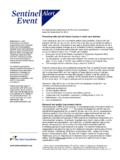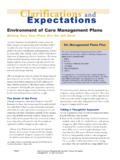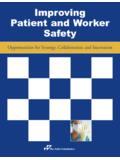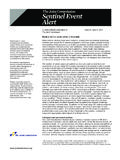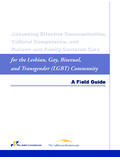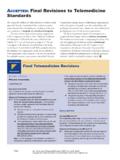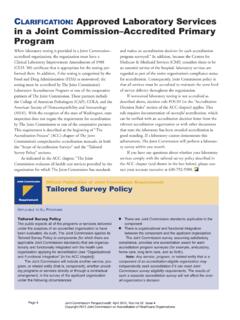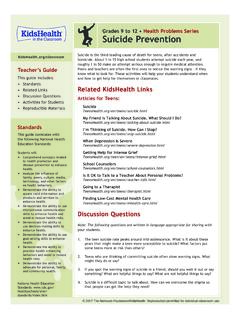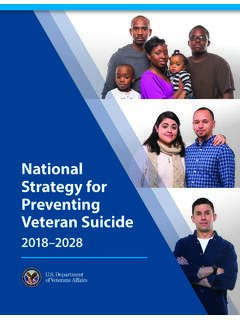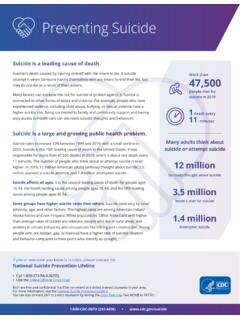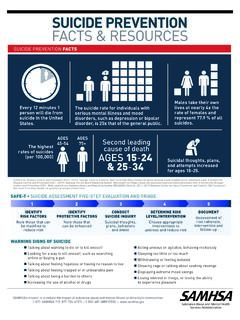Transcription of Suicide Prevention Resources to support Joint Commission ...
1 12 Suicide Prevention Resources to support Joint Commission Accredited organizations implementation of NPSG EP3,4 - Validated/ Evidence-Based Suicide Risk Assessment Tools Tools Brief Description Columbia- Suicide Severity Rating Scale (C-SSRS) Risk Assessment version SAFE-T with C-SSRS Author: Columbia University, the University of Pennsylvania, and the University of Pittsburgh supported by the National Institute of Mental Health (NIMH) Settings: All Population: all ages and special populations in different settings Availability: Free The C-SSRS Risk Assessment version can be used as a Suicide assessment tool following the use of one of the screening tools.
2 See The risk assessment version provides a checklist of protective and risk factors for Suicide , used along with the C-SSRS. The Columbia Protocol questions have also been incorporated into the SAMHSA SAFE-T model with recommended triage categories. See document SAFE-T Protocol with C-SSRS Recent. Note that the C-SSRS Full version, without the risk assessment, is not sufficient to qualify as an evidence-based Suicide risk assessment process. Assessment of the risk and protective factors, in a structured or unstructured way, is required in addition to the Suicide inquiry.
3 Recommending Organizations: Institute of Health Abuse and Mental Health Service AdministrationSAMHSA Action Alliance for Suicide Prevention (ActionAlliance) of National Center for Injury Prevention and States Food and Drug Administration FDAE vidence: The Columbia Lighthouse Project/Center for Suicide Risk Assessment. The Columbia Suicide Severity Rating Scale (C-SSRS) Supporting Evidence Last Revised 2-7-2018 Posner et al. The Columbia Suicide Severity Rating Scale: Initial Validity and Internal Consistency Findings from Three Multisite Studies with Adolescents and Adults Am J Psychiatry 2011;168: 126 6 1277) Scale for Suicide Ideation Worst (SSI-W; Beck et al.
4 , 1997) Settings: In-patient and out-patient settings The 19-item Scale for Suicide Ideation Worst (SSI-W; Beck et al., 1997) is an interviewer-administered rating scale that measures the intensity of patients specific attitudes, behaviors, and plans to commit Suicide during the time period that they were the most suicidal. The instrument was developed to obtain a more accurate estimate of Suicide risk. As with the SSI, each SSI-W item consists of three options graded according to the suicidal intensity on a 3-point scale ranging from 0 13 to 2.
5 The ratings are then summed to yield a total score, which ranges from 0 to 38. Individual items assess characteristics such as wish to die, desire to make an active or passive Suicide attempt, duration and frequency of ideation, sense of control over making an attempt, number of deterrents, and amount of actual preparation for a contemplated attempt. The SSI-W takes approximately 10 minutes to administer. (extract from Brown 2003, pg 7). Although the SSI-W has been used less frequently than the SSI, the reliability and validity of this measure have been established.
6 Evidence: Brown, G. (2003). A review of Suicide assessment measures for intervention research with adults and older adults. Bethesda, MD: National Institute of Mental Health. Beck, A. T., Brown, G. K., & Steer, R. A. (January 01, 1997). Psychometric characteristics of the Scale for Suicide Ideation with psychiatric outpatients. Behavior Research and Therapy, 35, 11, 1039-1046. Beck Scale for Suicide Ideation (BSI; Beck & Steer, 1991) Settings: In-patient and out-patient settings The Beck Scale for Suicide Ideation (BSI; Beck & Steer, 1991) is a 21-item self-report instrument for detecting and measuring the current intensity of the patients specific attitudes, behaviors, and plans to commit Suicide during the past week.
7 The BSI was developed as a self-report version of the interviewer-administered Scale for Suicide Ideation. The first 19 items consist of three options graded according to the intensity of the suicidality and rated on a 3-point scale ranging from 0 to 2. These ratings are then summed to yield a total score, which ranges from 0 to 38. Individual items assess characteristics such as wish to die, desire to make an active or passive Suicide attempt, duration and frequency of ideation, sense of control over making an attempt, number of deterrents, and amount of actual preparation for a contemplated attempt.
8 The last two items assess the number of previous Suicide attempts and the seriousness of the intent to die associated with the last attempt. As with the SSI, the BSI consists of five screening items. If the respondent reports any active or passive desire to commit Suicide , then an additional 14 items are administered. The BSI takes approximately 10 minutes to administer. Although the BSI is less widely used than the SSI, the BSI may be a viable alternative for measuring Suicide ideation using a self-report format.
9 (extract from Brown 2003: 8-9). 14 Evidence: Brown, G. (2003). A review of Suicide assessment measures for intervention research with adults and older adults. Bethesda, MD: National Institute of Mental Health. Kreuze E and Lamis D 2017 A Review of Psychometrically Tested Instruments Assessing Suicide Risk in Adults OMEGA Journal of Death and Dying 2018, Vol. 77(1) 36 90
